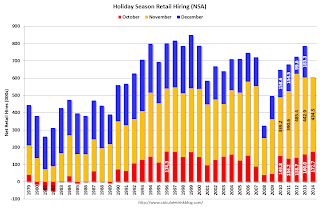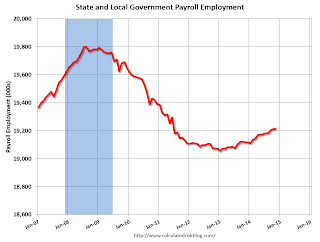by Calculated Risk on 12/05/2014 09:44:00 AM
Friday, December 05, 2014
Employment Report Comments: Best Year for Employment since the '90s
Earlier: November Employment Report: 321,000 Jobs, 5.8% Unemployment Rate
Last month I posted a possible list of economic words for the year since I started this blog. This included "bubble", "subprime", "bailout" and more. For 2014 I suggested "employment", and for 2015 I'm hoping for "wages". 2014 has definitely been about jobs!
This was a strong employment report with 321,000 jobs added, and job gains for September and October were revised up. This was the tenth consecutive month over 200,000, and an all time record 50th consecutive month of job gains.
As always we shouldn't read too much into one month of data, but at the current pace (through November), the economy will add 2.89 million jobs this year (2.80 million private sector jobs). This is the best year since 1999 (and, for private employment, this might be the best year since 1997).
A few other positives: U-6 declined to 11.4% (an alternative measure for labor underutilization) and was at the lowest level since 2008, the number of part time workers for economic reasons declined (lowest since October 2008), and the number of long term unemployed declined to the lowest level since January 2009.
And there might even be an early hint of wage growth, from the BLS: "Average hourly earnings for all employees on private nonfarm payrolls rose by 9 cents to $24.66 in November. Over the year, average hourly earnings have risen by 2.1 percent. In November, average hourly earnings of private-sector production and nonsupervisory employees increased by 4 cents to $20.74."
With the unemployment rate at 5.8%, there is still little upward pressure on wages. Hopefully wage growth will pick up as the unemployment rate falls over the next couple of years.
A few more numbers:
Total employment increased 321,000 from October to November and is now 1.7 million above the previous peak. Total employment is up 10.4 million from the employment recession low.
Private payroll employment increased 314,000 from October to November, and private employment is now 2.1 million above the previous peak. Private employment is up 10.9 million from the recession low.
Through the first eleven months of 2014, the economy has added 2,650,000 payroll jobs - up from 2,247,000 added during the same period in 2013. My expectation at the beginning of the year was the economy would add between 2.4 and 2.7 million payroll jobs this year - I was a little low!
Year-over-year Change in Employment

In November, the year-over-year change was 2.73 million jobs, and it appears the pace of hiring is increasing.
It seems very likely that 2014 will be the best year since 1999 for both total nonfarm and private sector employment growth.
Seasonal Retail Hiring
According to the BLS employment report, retailers hired seasonal workers in November at a solid pace, although slightly lower than in 2012.

Typically retail companies start hiring for the holiday season in October, and really increase hiring in November. Here is a graph that shows the historical net retail jobs added for October, November and December by year.
This graph really shows the collapse in retail hiring in 2008. Since then seasonal hiring has increased back close to more normal levels. Note: I expect the long term trend will be down with more and more internet holiday shopping.
This suggests retailers are reasonably optimistic about the holiday season. Note: There is a decent correlation between October seasonal retail hiring and holiday retail sales.
Employment-Population Ratio, 25 to 54 years old

In the earlier period the participation rate for this group was trending up as women joined the labor force. Since the early '90s, the participation rate moved more sideways, with a downward drift starting around '00 - and with ups and downs related to the business cycle.
The 25 to 54 participation rate was unchanged in November at 80.8%, and the 25 to 54 employment population ratio was unchanged at 76.9%. As the recovery continues, I expect the participation rate for this group to increase a little - although the participation rate has been trending down for this group since the late '90s.
Part Time for Economic Reasons

The number of persons employed part time for economic reasons (sometimes referred to as involuntary part-time workers), at 6.9 million, changed little in November.The number of persons working part time for economic reasons decreased in November to 6.850 million from 7.027 million in October. This suggests slack still in the labor market. These workers are included in the alternate measure of labor underutilization (U-6) that decreased to 11.4% in November from 11.5% in October.
This is the lowest level for U-6 since September 2008.
Unemployed over 26 Weeks
 This graph shows the number of workers unemployed for 27 weeks or more.
This graph shows the number of workers unemployed for 27 weeks or more. According to the BLS, there are 2.815 million workers who have been unemployed for more than 26 weeks and still want a job. This was down from 2.916 in October. This is trending down, but is still very high.
This is the lowest level for long term unemployed since January 2009.
State and Local Government
 This graph shows total state and government payroll employment since January 2007. State and local governments lost jobs for four straight years. (Note: Scale doesn't start at zero to better show the change.)
This graph shows total state and government payroll employment since January 2007. State and local governments lost jobs for four straight years. (Note: Scale doesn't start at zero to better show the change.) In November 2014, state and local governments added 2,000 jobs. State and local government employment is now up 157,000 from the bottom, but still 587,000 below the peak.
Clearly state and local employment is now increasing. And Federal government layoffs have slowed (payroll increased by 5 thousand in November), but Federal employment is still down 17,000 for the year.


